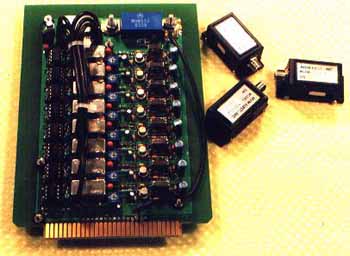|
Home Page >> How Laser Shows Work > Laser Projector |
|
How Laser Shows Work - Laser Projector The laser projector is where the laser beam is controlled and scanned to produce the effects you see in the show.
Colour Control The laser beam next encounters the colour control area. Laser shows either use a tandem laser pair (an Argon laser for the blue and green and a Krypton laser for the red) where the beams from the two lasers are combined to form a "white" beam; or a white light laser which produces red, green and blue from one laser. Colour control can be either subtractive - where unwanted colours are subtracted from the beam; or additive where colours are added to make the desired colour. Laser Lines Laserists (and scientists) speak of "lines" (measured in nanometers - nm for short) rather than colours, as the colour of the beam perceived by the eye is a function of the frequency of the photon oscillations. A HeNe laser typically produces a very pure red colour at 632.5 nm. Below is a chart showing some of the most common lines produced by lasers used in light shows.
A large and very detailed chart (in .tif format) showing all of the lines emitted by various types of lasers (contributed by one of our members, Brian) is available for download. SpectrumchartV10.zip (246 KB) The most typical forms forms of colour control used in laser shows (when you have a 'white' beam) are a colour box and a PCAOM (PolyChromatic Acousto Optic Modulator). Colour Box
The colour box is a subtractive device that uses three
actuators with dichroic filters mounted on the ends of the arms (one
cyan, one magenta and one yellow dichro) to select one of seven
colours that will be displayed. It has a relatively slow
response time as it is a mechanical device thus it can only produce a
limited number of colour changes in each frame. It has the advantage
of low cost and simple implementation.
At the other end of the scale
is the Poly Chromatic Acousto Optic Modulator (PCAOM), a
solid state, in-line device that allows for continuous
brightness control of multiple laser lines to generate
16.7 million or more colours at MHz speeds. The PCAOM acts as a
bulk diffraction grating which gives brightness control over the
individual laser lines. Just as a TV set combines variable
brightness of Red, Green and Blue to make the different colours you see on the
screen, the PCAOM allows for variable brightness control of a number of
laser lines (colours) that are added to create the desired output colours for projection.
For example, one can combine 100% of the red line(s) with 50% of the green
line(s) to produce an orange beam.  Eight line PCAOM driver card with 3 PCAOM cells to it's right - Photo courtesy of MVM
Beam Table
The output beams can be precisely positioned with adjustment screws on the the back of the kinematic mounts, so as to target remote mirrors that can then deflect the beam in a different direction. Using a four position beam table equipped with 50/50 splitters and mirrors, one can generate 8 beams out. By deflecting each of these beams from a remote bounce mirror, it gives the impression that there are many more beams in the venue (16 beams if each beam is bounced once from a remote mirror). The beam table actuators can also be sequenced to "chase" the beams around the venue. With a high speed sequence (where each actuator is engaged 15-20 times a second), the illusion that the beam table is projecting 8 beams at the same time is created. The beams are being switched on and off too fast for the eye to see thus it appears that all the beams are on at the same time. Beam Table Colour
Some beam tables use "fixed colour" where the 50/50 beamspliter
is replaced by a dichroic filter. When the actuator energizes, the
dichroic deflects a beam of a fixed colour while the mirror behind it
deflects the remaining colours passed by the dichroic filter. Whenever a
particular beam table position is activated, it always outputs the same
colours.
Scanning System The most important part of laser projection system are the galvos, more commonly called scanners. Graphics, animations, abstracts and dynamic beam effects are generated by X-Y scanning of the laser beam. The scanning system is covered in more detail on the Scanning Systems page.
Support Electronics The projector cabinet (or a separate electronics rack) usually includes all of the power supplies, cooling fans and driver cards used to make the projection system work. Support electronics may also include safety features such as power-off interlocks and scan fail detectors. [ Laser and exciter | Projector | Scanners | Control console | Graphics system | Outboard Equipment ]
|
|
©
1996-2008
Laser
F/X International and LaserFX.com - All rights reserved. |
|